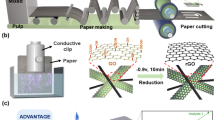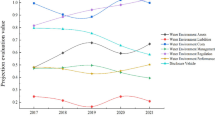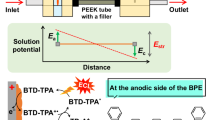Abstract
INTERPRETATION of the results of paper electrophoresis1–3 is complicated by liquid movement in the paper, due to hydrostatic flow, attainment of equilibrium in the paper, and electro-osmosis. Hydrostatic flow, due to the difference in level of buffer in the electrode vessels, can be eliminated by arranging a siphon between the vessels1.
This is a preview of subscription content, access via your institution
Access options
Similar content being viewed by others
References
Cremer, H. D., and Tiselius, A., Biochem. Z., 320, 273 (1950).
Durrum, E. L., J. Amer. Chem. Soc., 72, 2943 (1950).
Woods, E. F., and Gillespie, J. M., Aust. J. Biol. Sci., 6, 130 (1953).
Tiselius, A., Farad. Soc. Discuss., 13, 29 (1953).
Girard, A., and Sandulesco, G., Helv. Chim. Acta, 19, 1105 (1936).
Sommer, F., Schulz, O. F., and Nassan, M., Z. anorg. allgem. Chem., 147, 142 (1925).
Davidson, G. F., J. Text. Inst., 43, T291 (1952).
Muller, F., Helv. Chim. Acta, 22, 217 (1939).
Guthrie, J. D., Indust. Eng. Chem., 44, 2187 (1952).
Jermyn, M. A., and Thomas, R. (in preparation).
Author information
Authors and Affiliations
Rights and permissions
About this article
Cite this article
JERMYN, M., THOMAS, R. Reduction of Liquid Flow in Paper Electrophoresis. Nature 172, 728–729 (1953). https://doi.org/10.1038/172728a0
Issue date:
DOI: https://doi.org/10.1038/172728a0
This article is cited by
-
Zone Electrophoresis of Myrothrecium Cellulose
Nature (1958)
-
Untersuchungen zum Pr�albumin im menschlichen Serum
Klinische Wochenschrift (1958)



